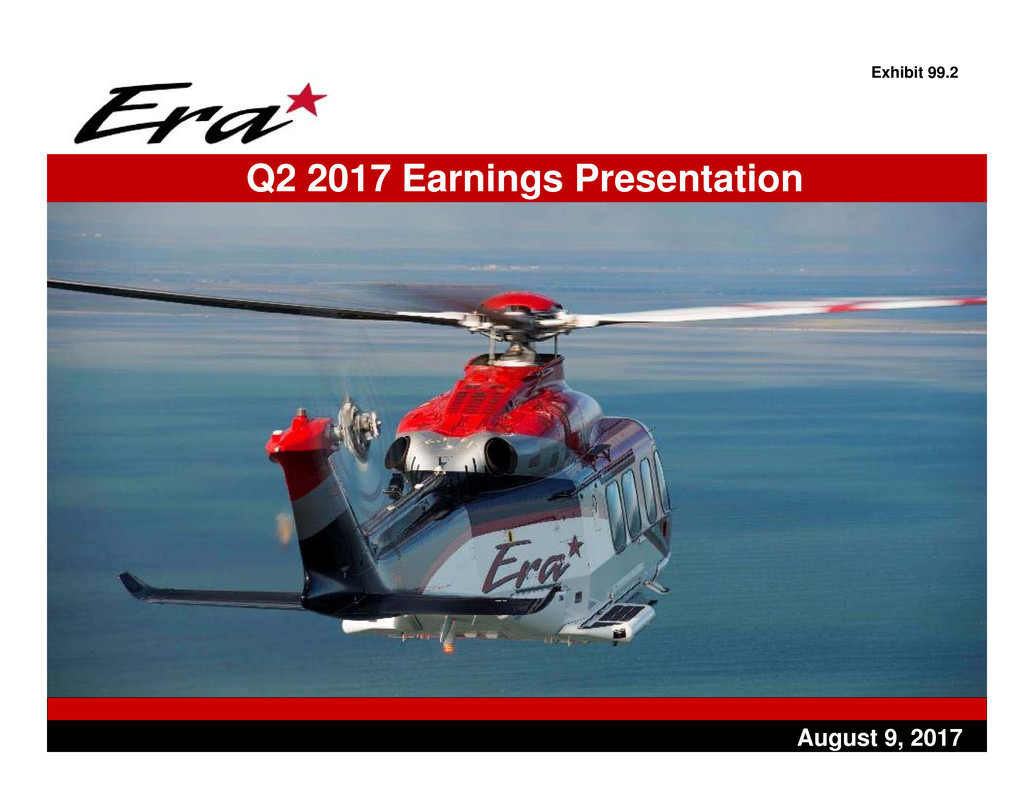
Q2 2017 Earnings Presentation
0August 9, 2017
Exhibit 99.2
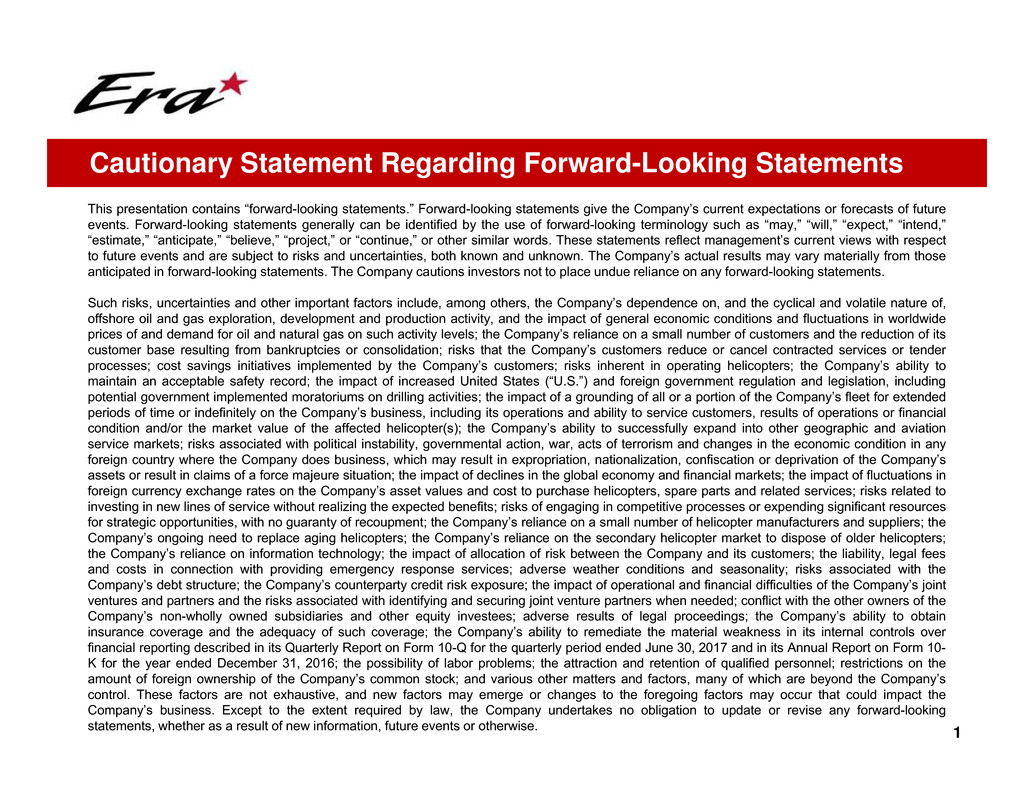
1
Cautionary Statement Regarding Forward-Looking Statements
This presentation contains “forward-looking statements.” Forward-looking statements give the Company’s current expectations or forecasts of future
events. Forward-looking statements generally can be identified by the use of forward-looking terminology such as “may,” “will,” “expect,” “intend,”
“estimate,” “anticipate,” “believe,” “project,” or “continue,” or other similar words. These statements reflect management’s current views with respect
to future events and are subject to risks and uncertainties, both known and unknown. The Company’s actual results may vary materially from those
anticipated in forward-looking statements. The Company cautions investors not to place undue reliance on any forward-looking statements.
Such risks, uncertainties and other important factors include, among others, the Company’s dependence on, and the cyclical and volatile nature of,
offshore oil and gas exploration, development and production activity, and the impact of general economic conditions and fluctuations in worldwide
prices of and demand for oil and natural gas on such activity levels; the Company’s reliance on a small number of customers and the reduction of its
customer base resulting from bankruptcies or consolidation; risks that the Company’s customers reduce or cancel contracted services or tender
processes; cost savings initiatives implemented by the Company’s customers; risks inherent in operating helicopters; the Company’s ability to
maintain an acceptable safety record; the impact of increased United States (“U.S.”) and foreign government regulation and legislation, including
potential government implemented moratoriums on drilling activities; the impact of a grounding of all or a portion of the Company’s fleet for extended
periods of time or indefinitely on the Company’s business, including its operations and ability to service customers, results of operations or financial
condition and/or the market value of the affected helicopter(s); the Company’s ability to successfully expand into other geographic and aviation
service markets; risks associated with political instability, governmental action, war, acts of terrorism and changes in the economic condition in any
foreign country where the Company does business, which may result in expropriation, nationalization, confiscation or deprivation of the Company’s
assets or result in claims of a force majeure situation; the impact of declines in the global economy and financial markets; the impact of fluctuations in
foreign currency exchange rates on the Company’s asset values and cost to purchase helicopters, spare parts and related services; risks related to
investing in new lines of service without realizing the expected benefits; risks of engaging in competitive processes or expending significant resources
for strategic opportunities, with no guaranty of recoupment; the Company’s reliance on a small number of helicopter manufacturers and suppliers; the
Company’s ongoing need to replace aging helicopters; the Company’s reliance on the secondary helicopter market to dispose of older helicopters;
the Company’s reliance on information technology; the impact of allocation of risk between the Company and its customers; the liability, legal fees
and costs in connection with providing emergency response services; adverse weather conditions and seasonality; risks associated with the
Company’s debt structure; the Company’s counterparty credit risk exposure; the impact of operational and financial difficulties of the Company’s joint
ventures and partners and the risks associated with identifying and securing joint venture partners when needed; conflict with the other owners of the
Company’s non-wholly owned subsidiaries and other equity investees; adverse results of legal proceedings; the Company’s ability to obtain
insurance coverage and the adequacy of such coverage; the Company’s ability to remediate the material weakness in its internal controls over
financial reporting described in its Quarterly Report on Form 10-Q for the quarterly period ended June 30, 2017 and in its Annual Report on Form 10-
K for the year ended December 31, 2016; the possibility of labor problems; the attraction and retention of qualified personnel; restrictions on the
amount of foreign ownership of the Company’s common stock; and various other matters and factors, many of which are beyond the Company’s
control. These factors are not exhaustive, and new factors may emerge or changes to the foregoing factors may occur that could impact the
Company’s business. Except to the extent required by law, the Company undertakes no obligation to update or revise any forward-looking
statements, whether as a result of new information, future events or otherwise.
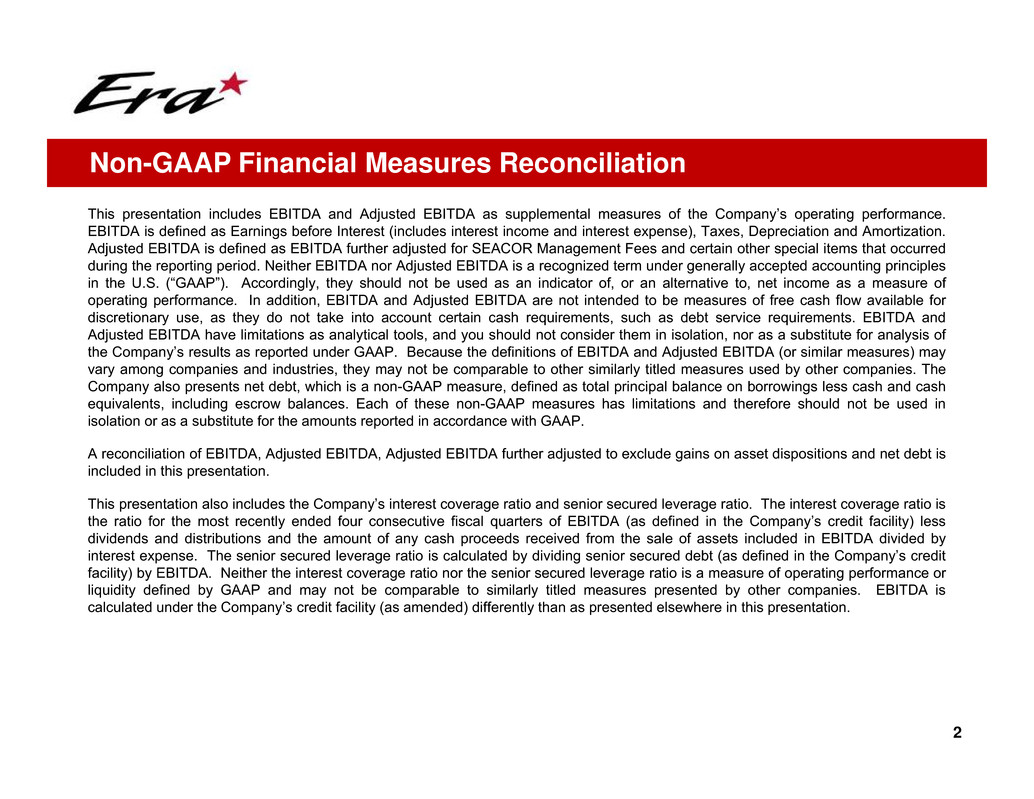
2
This presentation includes EBITDA and Adjusted EBITDA as supplemental measures of the Company’s operating performance.
EBITDA is defined as Earnings before Interest (includes interest income and interest expense), Taxes, Depreciation and Amortization.
Adjusted EBITDA is defined as EBITDA further adjusted for SEACOR Management Fees and certain other special items that occurred
during the reporting period. Neither EBITDA nor Adjusted EBITDA is a recognized term under generally accepted accounting principles
in the U.S. (“GAAP”). Accordingly, they should not be used as an indicator of, or an alternative to, net income as a measure of
operating performance. In addition, EBITDA and Adjusted EBITDA are not intended to be measures of free cash flow available for
discretionary use, as they do not take into account certain cash requirements, such as debt service requirements. EBITDA and
Adjusted EBITDA have limitations as analytical tools, and you should not consider them in isolation, nor as a substitute for analysis of
the Company’s results as reported under GAAP. Because the definitions of EBITDA and Adjusted EBITDA (or similar measures) may
vary among companies and industries, they may not be comparable to other similarly titled measures used by other companies. The
Company also presents net debt, which is a non-GAAP measure, defined as total principal balance on borrowings less cash and cash
equivalents, including escrow balances. Each of these non-GAAP measures has limitations and therefore should not be used in
isolation or as a substitute for the amounts reported in accordance with GAAP.
A reconciliation of EBITDA, Adjusted EBITDA, Adjusted EBITDA further adjusted to exclude gains on asset dispositions and net debt is
included in this presentation.
This presentation also includes the Company’s interest coverage ratio and senior secured leverage ratio. The interest coverage ratio is
the ratio for the most recently ended four consecutive fiscal quarters of EBITDA (as defined in the Company’s credit facility) less
dividends and distributions and the amount of any cash proceeds received from the sale of assets included in EBITDA divided by
interest expense. The senior secured leverage ratio is calculated by dividing senior secured debt (as defined in the Company’s credit
facility) by EBITDA. Neither the interest coverage ratio nor the senior secured leverage ratio is a measure of operating performance or
liquidity defined by GAAP and may not be comparable to similarly titled measures presented by other companies. EBITDA is
calculated under the Company’s credit facility (as amended) differently than as presented elsewhere in this presentation.
Non-GAAP Financial Measures Reconciliation
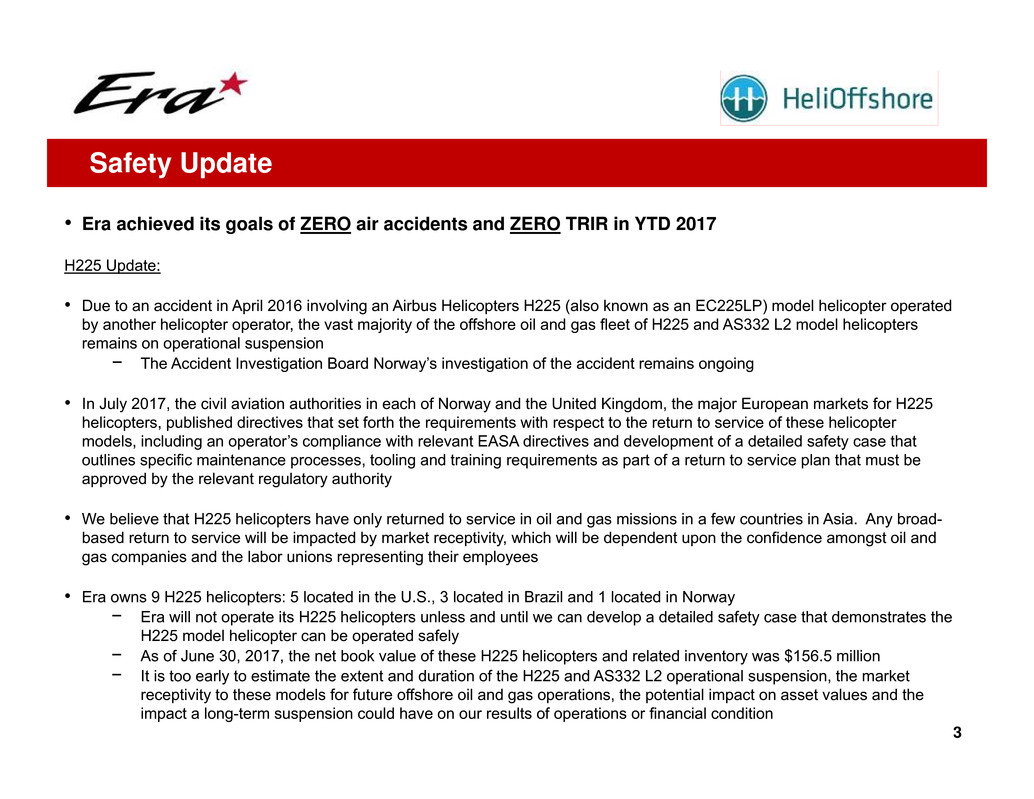
• Era achieved its goals of ZERO air accidents and ZERO TRIR in YTD 2017
H225 Update:
• Due to an accident in April 2016 involving an Airbus Helicopters H225 (also known as an EC225LP) model helicopter operated
by another helicopter operator, the vast majority of the offshore oil and gas fleet of H225 and AS332 L2 model helicopters
remains on operational suspension
− The Accident Investigation Board Norway’s investigation of the accident remains ongoing
• In July 2017, the civil aviation authorities in each of Norway and the United Kingdom, the major European markets for H225
helicopters, published directives that set forth the requirements with respect to the return to service of these helicopter
models, including an operator’s compliance with relevant EASA directives and development of a detailed safety case that
outlines specific maintenance processes, tooling and training requirements as part of a return to service plan that must be
approved by the relevant regulatory authority
• We believe that H225 helicopters have only returned to service in oil and gas missions in a few countries in Asia. Any broad-
based return to service will be impacted by market receptivity, which will be dependent upon the confidence amongst oil and
gas companies and the labor unions representing their employees
• Era owns 9 H225 helicopters: 5 located in the U.S., 3 located in Brazil and 1 located in Norway
− Era will not operate its H225 helicopters unless and until we can develop a detailed safety case that demonstrates the
H225 model helicopter can be operated safely
− As of June 30, 2017, the net book value of these H225 helicopters and related inventory was $156.5 million
− It is too early to estimate the extent and duration of the H225 and AS332 L2 operational suspension, the market
receptivity to these models for future offshore oil and gas operations, the potential impact on asset values and the
impact a long-term suspension could have on our results of operations or financial condition
3
Safety Update
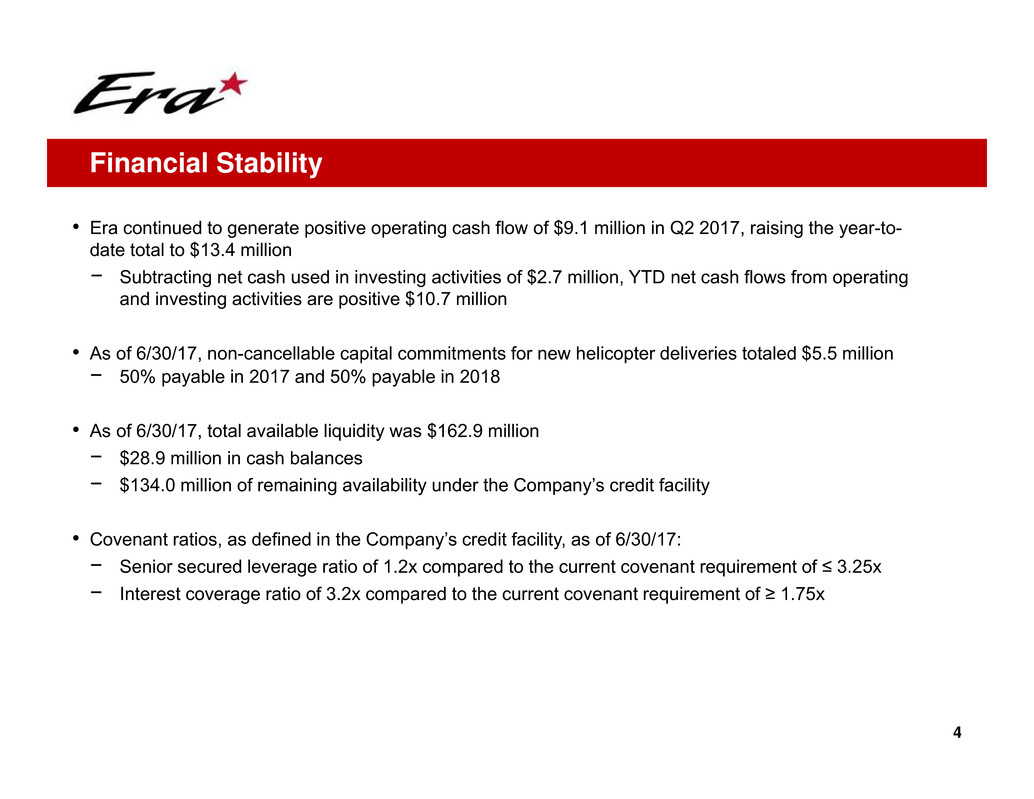
• Era continued to generate positive operating cash flow of $9.1 million in Q2 2017, raising the year-to-
date total to $13.4 million
− Subtracting net cash used in investing activities of $2.7 million, YTD net cash flows from operating
and investing activities are positive $10.7 million
• As of 6/30/17, non-cancellable capital commitments for new helicopter deliveries totaled $5.5 million
− 50% payable in 2017 and 50% payable in 2018
• As of 6/30/17, total available liquidity was $162.9 million
− $28.9 million in cash balances
− $134.0 million of remaining availability under the Company’s credit facility
• Covenant ratios, as defined in the Company’s credit facility, as of 6/30/17:
− Senior secured leverage ratio of 1.2x compared to the current covenant requirement of ≤ 3.25x
− Interest coverage ratio of 3.2x compared to the current covenant requirement of ≥ 1.75x
4
Financial Stability
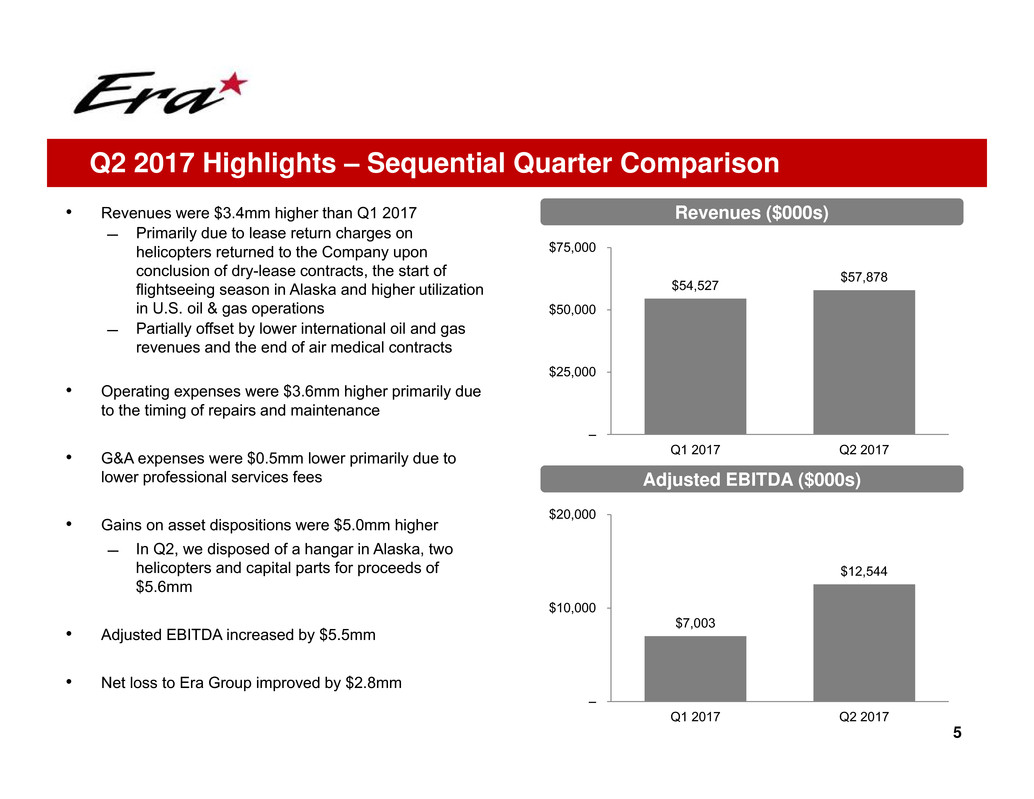
• Revenues were $3.4mm higher than Q1 2017
̶ Primarily due to lease return charges on
helicopters returned to the Company upon
conclusion of dry-lease contracts, the start of
flightseeing season in Alaska and higher utilization
in U.S. oil & gas operations
̶ Partially offset by lower international oil and gas
revenues and the end of air medical contracts
• Operating expenses were $3.6mm higher primarily due
to the timing of repairs and maintenance
• G&A expenses were $0.5mm lower primarily due to
lower professional services fees
• Gains on asset dispositions were $5.0mm higher
̶ In Q2, we disposed of a hangar in Alaska, two
helicopters and capital parts for proceeds of
$5.6mm
• Adjusted EBITDA increased by $5.5mm
• Net loss to Era Group improved by $2.8mm
5
Q2 2017 Highlights – Sequential Quarter Comparison
Revenues ($000s)
Adjusted EBITDA ($000s)
$54,527
$57,878
–
$25,000
$50,000
$75,000
Q1 2017 Q2 2017
$7,003
$12,544
–
$10,000
$20,000
Q1 2017 Q2 2017
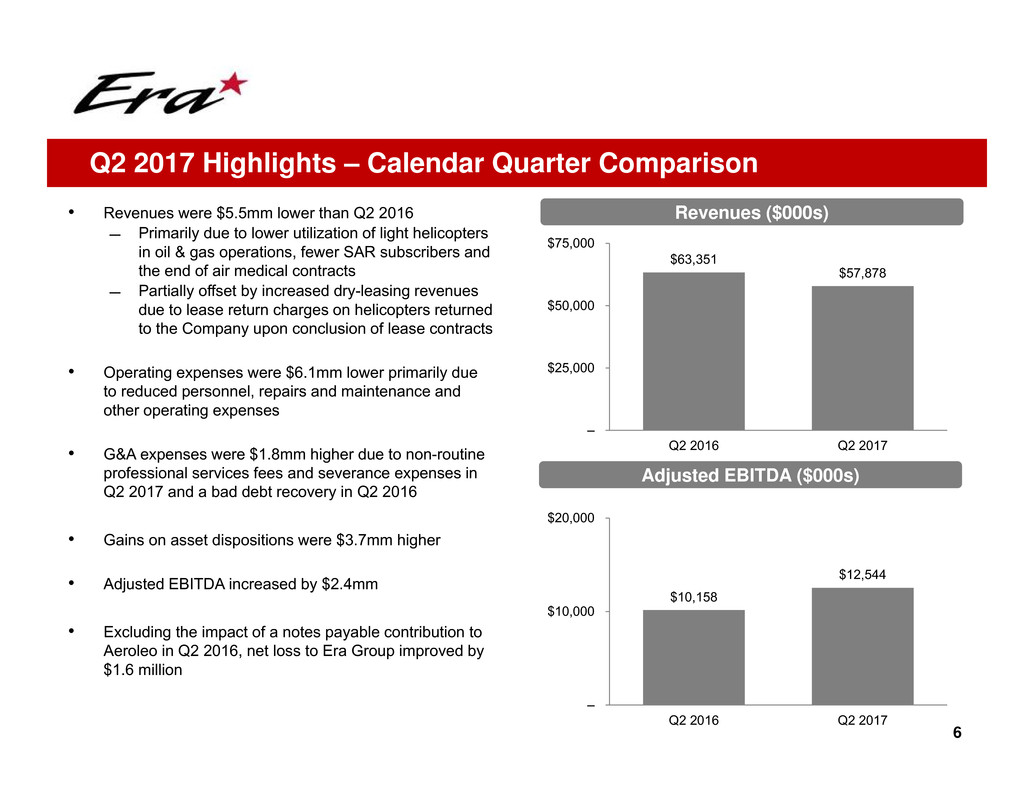
• Revenues were $5.5mm lower than Q2 2016
̶ Primarily due to lower utilization of light helicopters
in oil & gas operations, fewer SAR subscribers and
the end of air medical contracts
̶ Partially offset by increased dry-leasing revenues
due to lease return charges on helicopters returned
to the Company upon conclusion of lease contracts
• Operating expenses were $6.1mm lower primarily due
to reduced personnel, repairs and maintenance and
other operating expenses
• G&A expenses were $1.8mm higher due to non-routine
professional services fees and severance expenses in
Q2 2017 and a bad debt recovery in Q2 2016
• Gains on asset dispositions were $3.7mm higher
• Adjusted EBITDA increased by $2.4mm
• Excluding the impact of a notes payable contribution to
Aeroleo in Q2 2016, net loss to Era Group improved by
$1.6 million
6
Q2 2017 Highlights – Calendar Quarter Comparison
Revenues ($000s)
Adjusted EBITDA ($000s)
$63,351
$57,878
–
$25,000
$50,000
$75,000
Q2 2016 Q2 2017
$10,158
$12,544
–
$10,000
$20,000
Q2 2016 Q2 2017
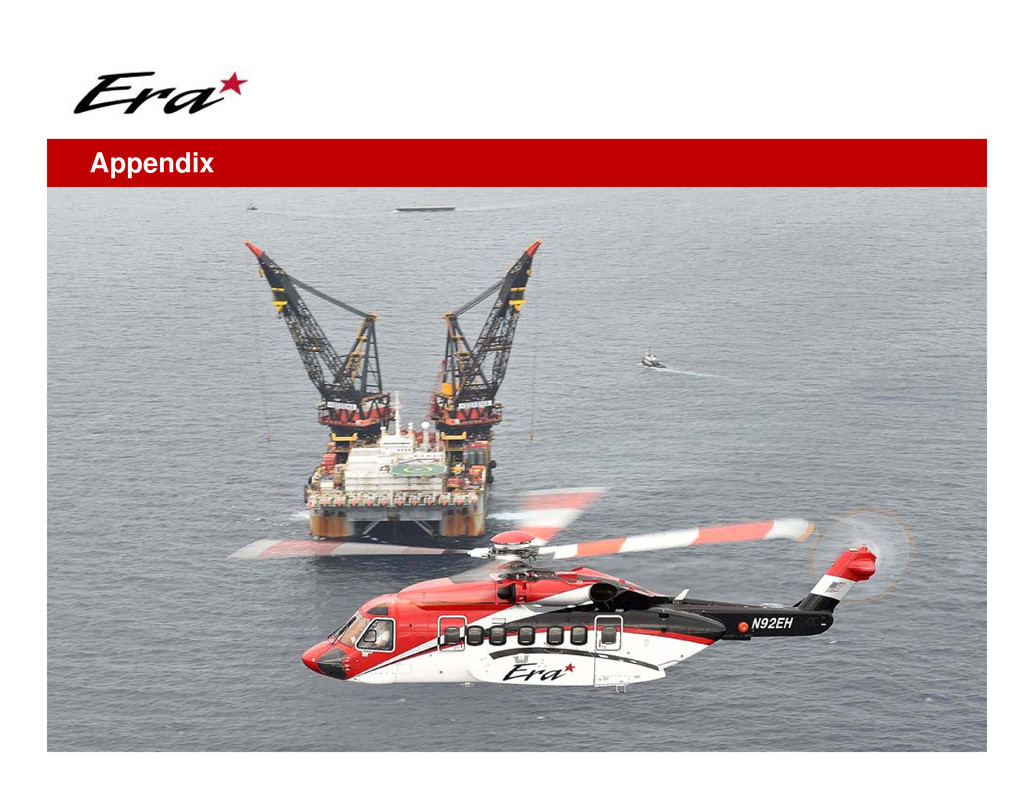
7
Appendix
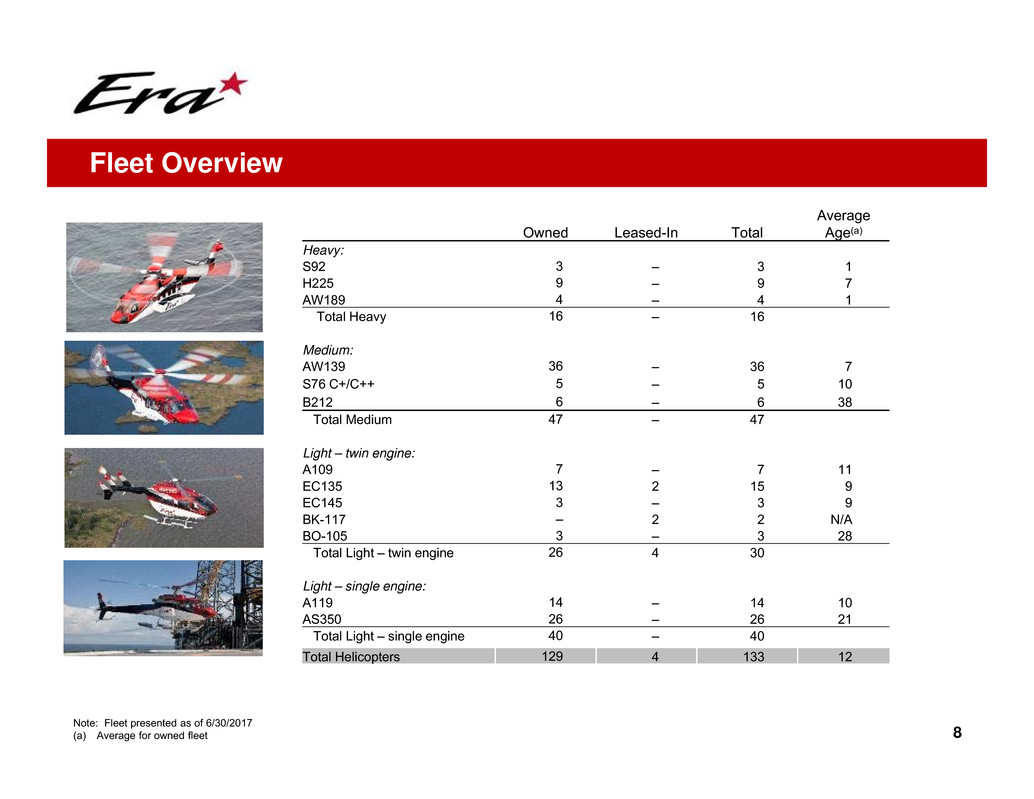
8
Owned Leased-In Total
Average
Age(a)
Heavy:
S92 3 – 3 1
H225 9 – 9 7
AW189 4 – 4 1
Total Heavy 16 – 16
Medium:
AW139 36 – 36 7
S76 C+/C++ 5 – 5 10
B212 6 – 6 38
Total Medium 47 – 47
Light – twin engine:
A109 7 – 7 11
EC135 13 2 15 9
EC145 3 – 3 9
BK-117 – 2 2 N/A
BO-105 3 – 3 28
Total Light – twin engine 26 4 30
Light – single engine:
A119 14 – 14 10
AS350 26 – 26 21
Total Light – single engine 40 – 40
Total Helicopters 129 4 133 12
Note: Fleet presented as of 6/30/2017
(a) Average for owned fleet
Fleet Overview
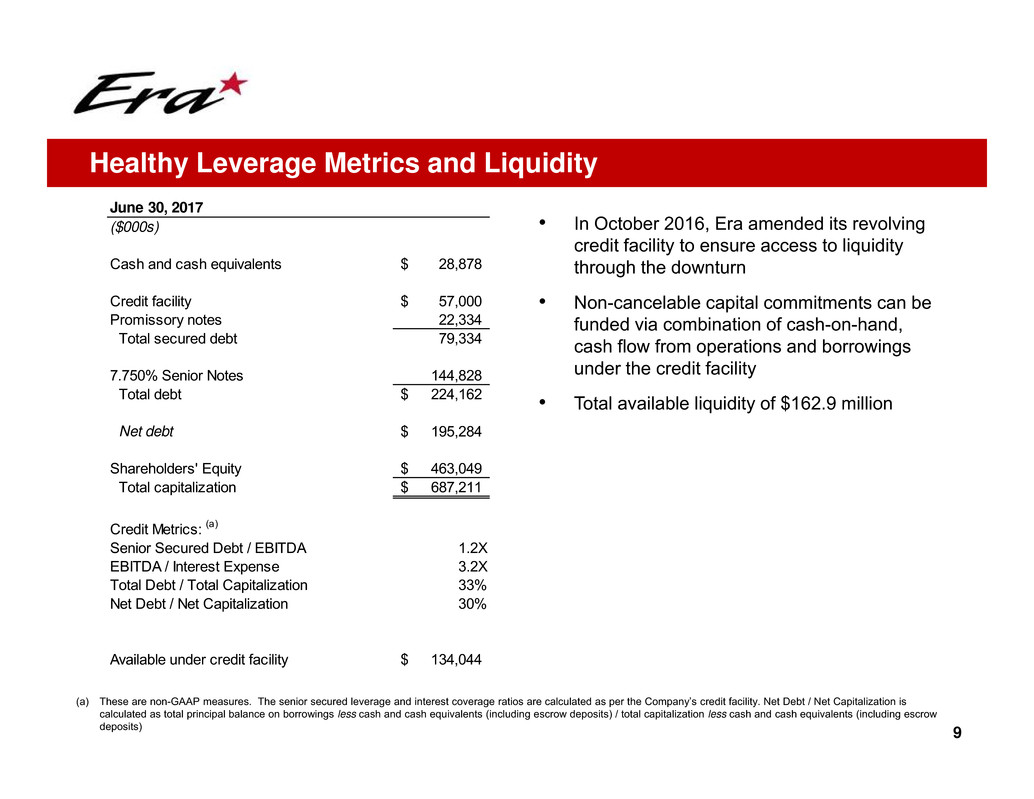
9
• In October 2016, Era amended its revolving
credit facility to ensure access to liquidity
through the downturn
• Non-cancelable capital commitments can be
funded via combination of cash-on-hand,
cash flow from operations and borrowings
under the credit facility
• Total available liquidity of $162.9 million
Healthy Leverage Metrics and Liquidity
(a) These are non-GAAP measures. The senior secured leverage and interest coverage ratios are calculated as per the Company’s credit facility. Net Debt / Net Capitalization is
calculated as total principal balance on borrowings less cash and cash equivalents (including escrow deposits) / total capitalization less cash and cash equivalents (including escrow
deposits)
June 30, 2017
($000s)
Cash and cash equivalents 28,878$
Credit facility 57,000$
Promissory notes 22,334
Total secured debt 79,334
7.750% Senior Notes 144,828
Total debt 224,162$
Net debt 195,284$
Shareholders' Equity 463,049$
Total capitalization 687,211$
Credit Metrics: (a)
Senior Secured Debt / EBITDA 1.2X
EBITDA / Interest Expense 3.2X
Total Debt / Total Capitalization 33%
Net Debt / Net Capitalization 30%
Available under credit facility 134,044$
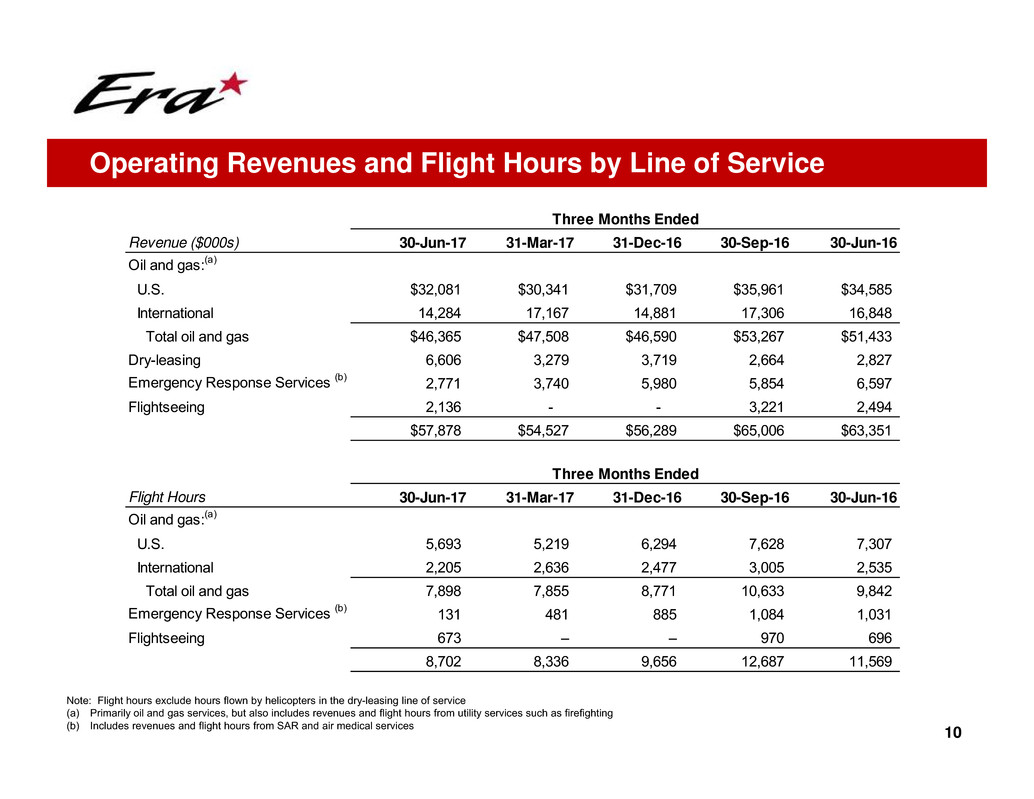
10
Operating Revenues and Flight Hours by Line of Service
Note: Flight hours exclude hours flown by helicopters in the dry-leasing line of service
(a) Primarily oil and gas services, but also includes revenues and flight hours from utility services such as firefighting
(b) Includes revenues and flight hours from SAR and air medical services
Revenue ($000s) 30-Jun-17 31-Mar-17 31-Dec-16 30-Sep-16 30-Jun-16
Oil and gas:(a)
U.S. $32,081 $30,341 $31,709 $35,961 $34,585
International 14,284 17,167 14,881 17,306 16,848
Total oil and gas $46,365 $47,508 $46,590 $53,267 $51,433
Dry-leasing 6,606 3,279 3,719 2,664 2,827
Emergency Response Services (b) 2,771 3,740 5,980 5,854 6,597
Flightseeing 2,136 - - 3,221 2,494
$57,878 $54,527 $56,289 $65,006 $63,351
Flight Hours 30-Jun-17 31-Mar-17 31-Dec-16 30-Sep-16 30-Jun-16
Oil and gas:(a)
U.S. 5,693 5,219 6,294 7,628 7,307
International 2,205 2,636 2,477 3,005 2,535
Total oil and gas 7,898 7,855 8,771 10,633 9,842
Emergency Response Services (b) 131 481 885 1,084 1,031
Flightseeing 673 – – 970 696
8,702 8,336 9,656 12,687 11,569
Three Months Ended
Three Months Ended
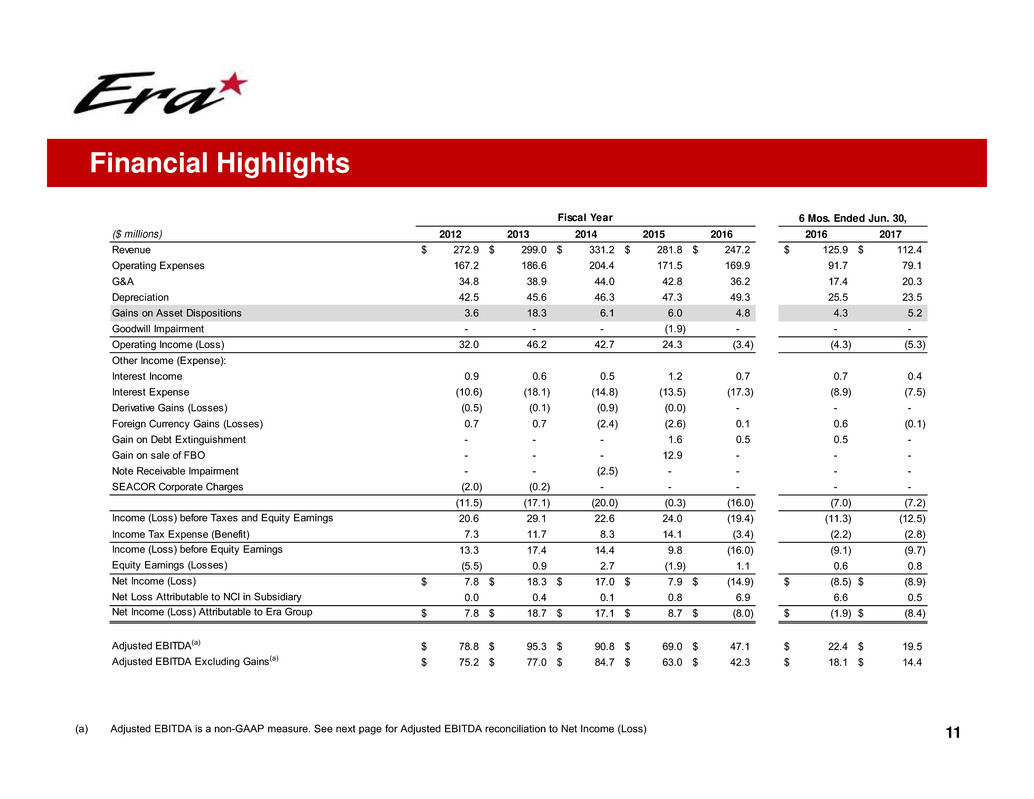
11(a) Adjusted EBITDA is a non-GAAP measure. See next page for Adjusted EBITDA reconciliation to Net Income (Loss)
Financial Highlights
Fiscal Year
($ millions) 2012 2013 2014 2015 2016 2016 2017
Revenue 272.9$ 299.0$ 331.2$ 281.8$ 247.2$ 125.9$ 112.4$
Operating Expenses 167.2 186.6 204.4 171.5 169.9 91.7 79.1
G&A 34.8 38.9 44.0 42.8 36.2 17.4 20.3
Depreciation 42.5 45.6 46.3 47.3 49.3 25.5 23.5
Gains on Asset Dispositions 3.6 18.3 6.1 6.0 4.8 4.3 5.2
Goodwill Impairment - - - (1.9) - - -
Operating Income (Loss) 32.0 46.2 42.7 24.3 (3.4) (4.3) (5.3)
Other Income (Expense):
Interest Income 0.9 0.6 0.5 1.2 0.7 0.7 0.4
Interest Expense (10.6) (18.1) (14.8) (13.5) (17.3) (8.9) (7.5)
Derivative Gains (Losses) (0.5) (0.1) (0.9) (0.0) - - -
Foreign Currency Gains (Losses) 0.7 0.7 (2.4) (2.6) 0.1 0.6 (0.1)
Gain on Debt Extinguishment - - - 1.6 0.5 0.5 -
Gain on sale of FBO - - - 12.9 - - -
Note Receivable Impairment - - (2.5) - - - -
SEACOR Corporate Charges (2.0) (0.2) - - - - -
(11.5) (17.1) (20.0) (0.3) (16.0) (7.0) (7.2)
Income (Loss) before Taxes and Equity Earnings 20.6 29.1 22.6 24.0 (19.4) (11.3) (12.5)
Income Tax Expense (Benefit) 7.3 11.7 8.3 14.1 (3.4) (2.2) (2.8)
Income (Loss) before Equity Earnings 13.3 17.4 14.4 9.8 (16.0) (9.1) (9.7)
Equity Earnings (Losses) (5.5) 0.9 2.7 (1.9) 1.1 0.6 0.8
Net Income (Loss) 7.8$ 18.3$ 17.0$ 7.9$ (14.9)$ (8.5)$ (8.9)$
Net Loss Attributable to NCI in Subsidiary 0.0 0.4 0.1 0.8 6.9 6.6 0.5
Net Income (Loss) Attributable to Era Group 7.8$ 18.7$ 17.1$ 8.7$ (8.0)$ (1.9)$ (8.4)$
Adjusted EBITDA(a) 78.8$ 95.3$ 90.8$ 69.0$ 47.1$ 22.4$ 19.5$
Adjusted EBITDA Excluding Gains(a) 75.2$ 77.0$ 84.7$ 63.0$ 42.3$ 18.1$ 14.4$
6 Mos. Ended Jun. 30,
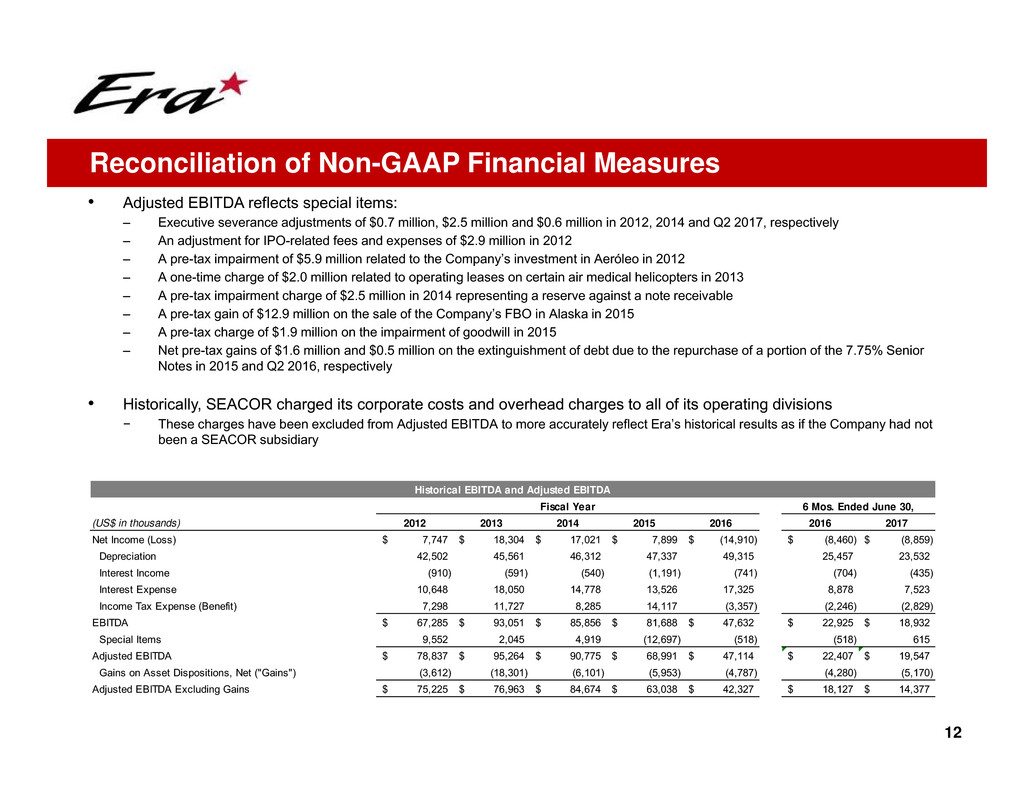
• Adjusted EBITDA reflects special items:
– Executive severance adjustments of $0.7 million, $2.5 million and $0.6 million in 2012, 2014 and Q2 2017, respectively
– An adjustment for IPO-related fees and expenses of $2.9 million in 2012
– A pre-tax impairment of $5.9 million related to the Company’s investment in Aeróleo in 2012
– A one-time charge of $2.0 million related to operating leases on certain air medical helicopters in 2013
– A pre-tax impairment charge of $2.5 million in 2014 representing a reserve against a note receivable
– A pre-tax gain of $12.9 million on the sale of the Company’s FBO in Alaska in 2015
– A pre-tax charge of $1.9 million on the impairment of goodwill in 2015
– Net pre-tax gains of $1.6 million and $0.5 million on the extinguishment of debt due to the repurchase of a portion of the 7.75% Senior
Notes in 2015 and Q2 2016, respectively
• Historically, SEACOR charged its corporate costs and overhead charges to all of its operating divisions
− These charges have been excluded from Adjusted EBITDA to more accurately reflect Era’s historical results as if the Company had not
been a SEACOR subsidiary
12
Reconciliation of Non-GAAP Financial Measures
Historical EBITDA and Adjusted EBITDA
6 Mos. Ended June 30,
(US$ in thousands) 2012 2013 2014 2015 2016 2016 2017
Net Income (Loss) 7,747$ 18,304$ 17,021$ 7,899$ (14,910)$ (8,460)$ (8,859)$
Depreciation 42,502 45,561 46,312 47,337 49,315 25,457 23,532
Interest Income (910) (591) (540) (1,191) (741) (704) (435)
Interest Expense 10,648 18,050 14,778 13,526 17,325 8,878 7,523
Income Tax Expense (Benefit) 7,298 11,727 8,285 14,117 (3,357) (2,246) (2,829)
EBITDA 67,285$ 93,051$ 85,856$ 81,688$ 47,632$ 22,925$ 18,932$
Special Items 9,552 2,045 4,919 (12,697) (518) (518) 615
Adjusted EBITDA 78,837$ 95,264$ 90,775$ 68,991$ 47,114$ 22,407$ 19,547$
Gains on Asset Dispositions, Net ("Gains") (3,612) (18,301) (6,101) (5,953) (4,787) (4,280) (5,170)
Adjusted EBITDA Excluding Gains 75,225$ 76,963$ 84,674$ 63,038$ 42,327$ 18,127$ 14,377$
Fiscal Year
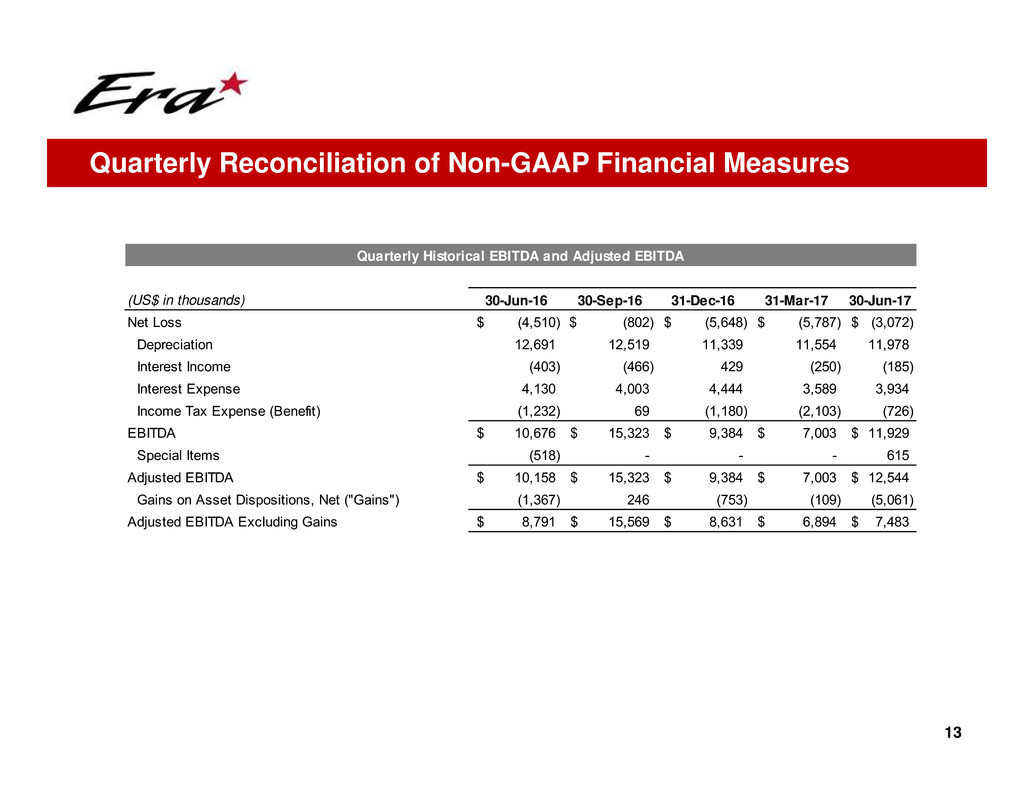
13
Quarterly Reconciliation of Non-GAAP Financial Measures
(US$ in thousands) 30-Jun-16 30-Sep-16 31-Dec-16 31-Mar-17 30-Jun-17
Net Loss (4,510)$ (802)$ (5,648)$ (5,787)$ (3,072)$
Depreciation 12,691 12,519 11,339 11,554 11,978
Interest Income (403) (466) 429 (250) (185)
Interest Expense 4,130 4,003 4,444 3,589 3,934
Income Tax Expense (Benefit) (1,232) 69 (1,180) (2,103) (726)
EBITDA 10,676$ 15,323$ 9,384$ 7,003$ 11,929$
Special Items (518) - - - 615
Adjusted EBITDA 10,158$ 15,323$ 9,384$ 7,003$ 12,544$
Gains on Asset Dispositions, Net ("Gains") (1,367) 246 (753) (109) (5,061)
Adjusted EBITDA Excluding Gains 8,791$ 15,569$ 8,631$ 6,894$ 7,483$
Quarterly Historical EBITDA and Adjusted EBITDA